![]()
![]()
![]()
Use LEFT and RIGHT arrow keys to navigate between flashcards;
Use UP and DOWN arrow keys to flip the card;
H to show hint;
A reads text to speech;
30 Cards in this Set
- Front
- Back
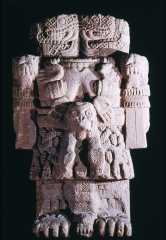
|
Coatlicue, Tenochtitlan c. 1487-1520 - earth mother from whom Mexica originated - 8 ft in height - ("Serpent Skirt") |
|
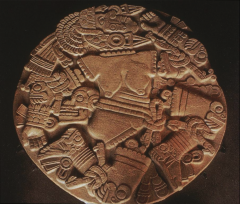
|
Coyolxauhqui Relief, Tenochtitlan c. 1469 - 11 ft. diameter, 9 tons - found at the base of some pyramids - nudity= uncivilized |
|

|
Pont du Gard, Nimes (France) late 1st century BCE - Ancient Roman aqueduct - roman style arches - limestone - shows their desire to control nature - shows the spread of the Roman Empire through Europe |
|
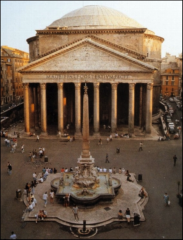
|
Pantheon, Rome 125 CE keywords: oculus, eye - light effect of dome: creates heaven like feeling, - has axial emphasis: clear front & clear hierarchy - derived from greek word meaning "of, relating to, or common to all the gods" |
|
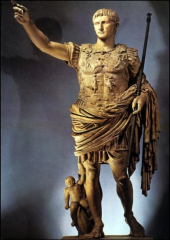
|
Augustus from Primaporta 125 CE - shows on the contrapposto- weight on left leg, right leg free - clothed- romans didn't like nudity - first roman emperor |
|
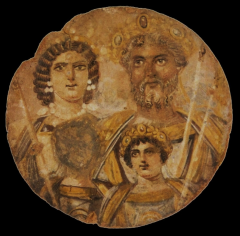
|
Severan family, painted portrait c. 200 CE keywords: damning of the memory (damnatiomemoriae),fresco |
|
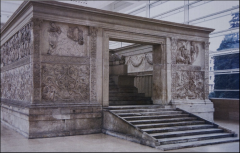
|
Ara Pacis Augustae (Altar of Augustan Peace) 13-9 BCE - Rome - leaves: symbolize transformation -- emporter Augustus transformed the empire - children: symbolize the future - altar in Rome dedicated to Pax, the roman goddess of Peace - reflects Augustan vision of Roman civil religion |
|
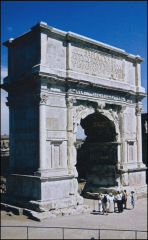
|
Arch of Titus after 81 CE Rome with scenes of spoils and triumphs keywords: triumphal arch, historicalrelief - constructed by roman emperor shortly after his brother, Titus, passed away to commemorate his victories - objects in high relief: you feel as if you're part of the crowd while walking through - marbel: expensive, heavy |
|
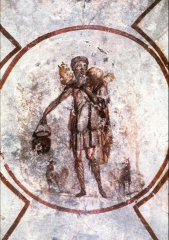
|
The Good Shepherd, Catacomb of Callistus 2nd century CE, Rome keywords: fresco - came from the hymn "The Lord is my Shepherd" - Catacombs were made to honor the dead |
|
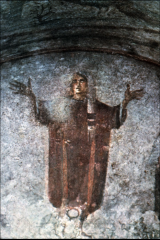
|
Orant Figure, Catacomb of Priscilla 3rd century CE, Rome keywords: fresco - advocate for the dead - praying for souls to go to heaven - used for Christian burials from the late 2nd century through the 4th century - some of the walls and ceilings display fine decorations illustrating Biblical scenes. |
|

|
Sarcophagus of Junius Bassus, Rome c. 359 CE - found in St. Peters Basilica - marbel - high relief - abstracted but realistic style - Depicts different scenes of Christianity: Christ in throne, Christ riding thru on donkey, Adam & Eve |
|

|
Mosaic of the Good Shepherd, Mausoleum of Galla Placidia, Ravenna, Italy c. 425 CE keywords: tesserae, Byzantine - unearthly - shows how Christ has risen among ranks: still seen as a shepherd but has nicer clothes and more sheep (sheep represent followers) - more elaborate |
|
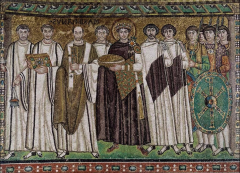
|
Mosaic of Justinian, San Vitale, Ravenna, Italy 546-548 CE keywords: tesserae, Byzantine - represents how Justinian is focal point of the art, shows his authority - can also be seen to give visual testament to the two major ambitions of Justinian's reign: as heir to the tradition of Roman Emperors, Justinian sought to restore the territorial boundaries of the Empire |
|

|
Mosaic of Theodora, San Vitale, Ravenna, Italy, 546-548 CE keywords: tesserae, Byzantine |
|
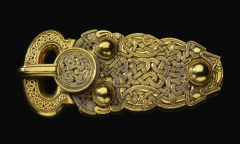
|
Gold Belt Buckle, Sutton Hoo, England c. 650 CE - ship burial - meant for someone really important (seen through the elaborate design and material use) - pre-Christian Britain |
|
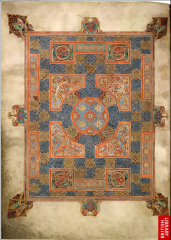
|
Carpet page, Lindisfarne Gospels, England c. 725 keywords: vellum (calf skin) - made of vellum - pages of mainly geometrical ornamentation, which may include repeated animal forms, typically placed at the beginning of each of the four Gospels in Gospel Books |
|
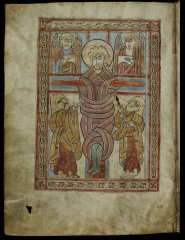
|
Crucifixion, St. Gall Gospels, Ireland
c. 750 - Jesus in stylistic manner: abstracted - legs are unnatural - theology of Christianity: connecting Earth to heavens |
|
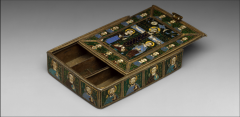
|
Reliquary of the True Cross, Byzantium late 8th century - early 9th century keywords: relic, intercession - enamel silver - abstracted crucified Christ - "In the small part is the power of the whole cross" |
|
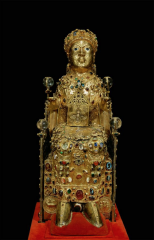
|
Reliquary of St. Foy, Conques, France c. 1000 keywords: relic, pilgrimage - Saints’ relics were regarded as the most valuable religious artifacts, and it was only appropriate to house them in the most magnificent of reliquaries. The reliquary at the Abbey of Sainte Foy in Conques is the last surviving example of an enthroned statue reliquary - This style of reliquary was common prior to the Romanesque period |
|
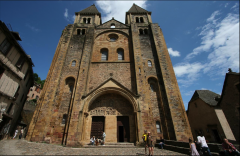
|
Church of St. Foy, Conques, France 11th century keywords: pilgrimage,nave, apse, Romanesque - rounded arches in front - imposing structure |
|
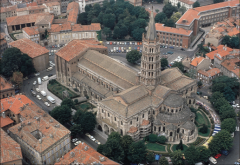
|
St. Sernin, Toulouse, France 1070-1120 keywords: nave, apse, romanesque - could be seen from anywhere in Toulouse |
|
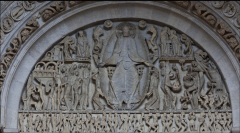
|
Gislebertus, Last Judgement Portal, Church of St. Lazare, Autun c. 1135 keywords: Romanesque - heaven vs. hell |
|
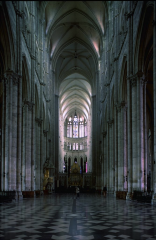
|
Cathedral of Notre Dame d'Amiens, France 1220-1269 keywords: Gothic,Fourth Lateran Council, flying buttresses - ribbed vaults |
|

|
Tympanum of Christ at the End of Time, Abbey Church of St. Denis, France c.1140 - Abbot suger (a patron) on the right-hand side of Christ |
|
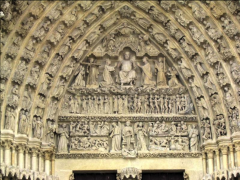
|
Last Judgement Portal, Cathedral of Notre Dame d'Amiens, France 1220-1269 - shows Christ's judgements - apostles, old testament virtues |
|

|
Beau Dieu, Cathedral of Notre Dame d'Amiens, France 1220-1269 Christas the “Beau Dieu” inthe trumeau - "beautiful as a god" |
|
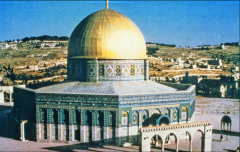
|
Dome of the Rock, Jerusalem built by Umayyad caliph 'Abd al-Malik 691-92 CE keywords: circumambulation, Qur’an - first Islamic shrine to the rock - both a shrine AND a mosque |
|
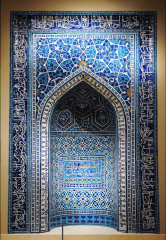
|
Mihrab, Metropolitan Museum, from a mosque in Iran 1354 keywords: Mihrab - represents the beauty in a mosque |
|
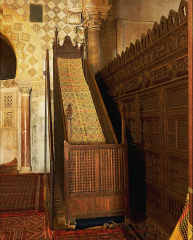
|
Minbar and Maqsura, Great Mosque of Qayrawan, Tunisa 1040 keywords: Minbar, Maqsure |
|
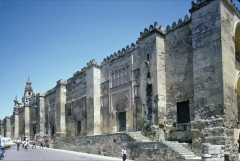
|
Hypostyle hall, Great Mosque of Cordoba 8th- early 11th century |

